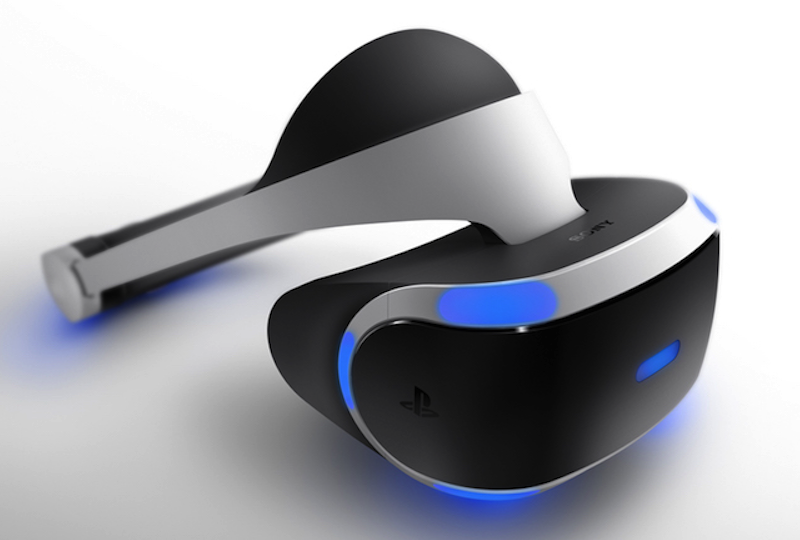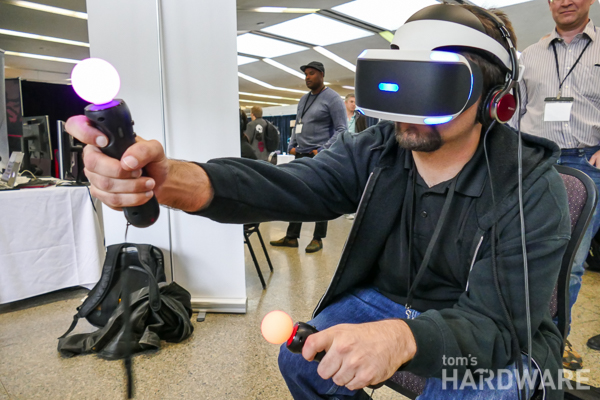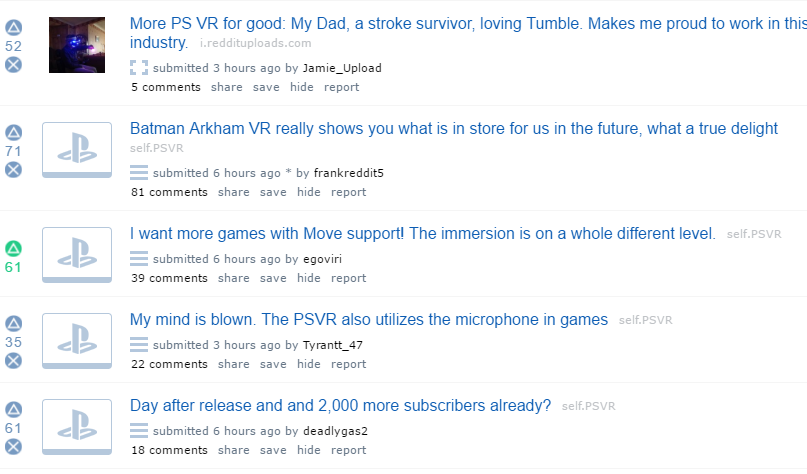Sony Doing Right By The VR Market, PSVR Impressing Fans
Sony finally launched the PlayStation VR, which rounds out the three big releases of The Year of VR with the HTC Vive and Oculus Rift. Sony’s kit is the most affordable of the three, and the company has an install base of over 40 million VR-ready consoles worldwide. That number is both a massive opportunity for Sony to dominate the VR market, and a massive responsibility to do it well. The PSVR holds the key to the early success of this new medium because it holds the key to millions of gamers' hearts worldwide.
The launch of the PSVR is a major milestone for Sony, but it's also poised to be either a massive blow or a major boon to the VR industry as a whole. Everyone involved in VR right now is relying on people sharing virtual reality with others. You simply can’t understand what VR is like until you’ve tried it, which is a major hurdle preventing mass adoption. In a way, the PSVR is a linchpin for the industry. If the PSVR fails to impress and turns off a large chunk of the potential VR market, other platforms will have a much harder time succeeding. On the other hand, if Sony knocks people’s socks off, they could be more likely to consider a higher end option in the future.
Valve and HTC came out swinging with an incredible Vive package, which set the bar high for high-end VR experiences. Oculus is an equal in terms of hardware design and material quality and is second to none in dollars invested to ensure that research and development in VR continues. HTC and Oculus can only dream of having the reach that Sony has during the incubation stages of this burgeoning industry, though. Given Sony’s history of launching consoles, the company could conceivably sell hundreds of thousands, if not millions of PSVR units before the end of the year.
So far, Sony appears to have hit it out of the park. We’re not ready to release our full review at this time, but our initial experience showed great promise. The PSVR is the most affordable “premium” VR experience that you can buy for home use, and it’s the only option available for the massive console gaming market. The hardware isn’t as robust as the Vive or the Rift, but it's nevertheless good enough to provide a great experience.
Sony nailed the details that count. The headset is comfortable to wear for long periods of time and doesn’t produce eye strain. The first time I put it on, I spent over 3 hours inside the HMD without even realizing it. The setup is also fairly straight forward; if you're capable of connecting your PS4 to your TV, you shouldn’t have any trouble setting up the PSVR. Best of all, you don’t have to walk through an elaborate setup process. Your PS4 will detect the PSVR HMD when you turn it on and automatically change the microphone input to the PSVR and enable the HMD's displays.
Sony also took steps to ensure that PSVR can be a social activity for you and your friends. There are games that offer asymmetric play, which allows one player to be in VR while others play on the TV, and when asymmetric play isn’t available, the TV is used to show everyone else what the VR player can see.
And we’re not the only people that are happy with the product Sony delivered. The PSVR subreddit is filled with accounts of how amazed people are with VR and the PSVR HMD. People are showing their friends and families, and they're genuinely excited about the hardware. And people with debilitating disabilities, such as one young man with cerebral palsy and an older gentleman who survived a stroke, are finding new joy from the PSVR experience.
Get Tom's Hardware's best news and in-depth reviews, straight to your inbox.
We believe Sony did right by the VR industry with the PSVR. The hardware is affordable enough to be interesting to many, and good enough to be worth considering as high-end VR option.
Kevin Carbotte is a contributing writer for Tom's Hardware who primarily covers VR and AR hardware. He has been writing for us for more than four years.
-
Jeff Fx >and the company has an install base of over 40 million VR-ready consoles worldwide.Reply
Didn't they say people would need the New PS 4.5 to get the full PSVR experience?
>The headset is comfortable to wear for long periods of time and doesn’t produce eye strain. The first time I put it on, I spent over 3 hours inside the HMD without even realizing it.
A comfortable headset with no eye-strain sounds really good. I had to heavily mod my Vive headset to make it more comfortable, and I still need to add some additional padding, because even welding headgear gets uncomfortable over time with a Vive attached to it.
>We believe Sony did right by the VR industry with the PSVR.
That's great. Like many, I was afraid they'd deliver a poor substitute for 2016 VR, and make people think that VR is still where it was a decade ago. -
philongames @Jeff FX: The PS4 Pro is not required; all games have to run at 90fps no matter what version of PS4 you own. PS4 Pro allows developers to access additional horsepower if they choose to use it, but it's not a requirement to have PS4 Pro specific enhancements to submit a game to Sony, and you aren't allowed to have features only available on the Pro that aren't on the regular PS4. So you will get things like higher quality effects, textures, and in the super rare case, a bump up to 120 FPS (Sony is the only HMD of the big 3 right now that supports this refresh rate).Reply -
Zapin It looks like the PSVR is working well considering the dated PS4 hardware (other than issues with the move controllers). Hopefully, they will not do VR a disservice by releasing too many half-baked VR demos pretending to be full fledged games. There are not many VR titles on any current platform that are worth a $50 price tag so if there is $5 worth of content the price of game should reflect that whether it is VR or not.Reply -
kcarbotte Reply18741685 said:>and the company has an install base of over 40 million VR-ready consoles worldwide.
Didn't they say people would need the New PS 4.5 to get the full PSVR experience?
>The headset is comfortable to wear for long periods of time and doesn’t produce eye strain. The first time I put it on, I spent over 3 hours inside the HMD without even realizing it.
A comfortable headset with no eye-strain sounds really good. I had to heavily mod my Vive headset to make it more comfortable, and I still need to add some additional padding, because even welding headgear gets uncomfortable over time with a Vive attached to it.
>We believe Sony did right by the VR industry with the PSVR.
That's great. Like many, I was afraid they'd deliver a poor substitute for 2016 VR, and make people think that VR is still where it was a decade ago.
PSVR works just fine on the regular PS4. You can't even get the new one yet.
The new system might increase the graphics fidelity a little bit.
If you know how to adjust the Vive's strap properly, it can be very comfortable. I prefer it over the Rift, actually. Most people don't realize that the strap needs to sit low on the back of the scull. As low as you can get it. It should be below the ridge on the back of your skull. All the weight should rest on your forhead, none on your cheeks.
Most people don't sit the strap low enough and compensate by pulling the strap tight, which is very uncomfortable.
-
old_newbie This is actually what the VR market needs right now: a heavyweight like Sony utilizing their install base and pushing VR experiences to the masses. Hopefully they will keep up the in-store demos. I'm convinced there just is no other way to get new potential VR users on board and expand the market, other than getting people to actually try VR...whether it be PSVR, Vive, Rift, or whatever. I demoed a Vive this past summer and I will, without a doubt, be buying a Vive this Christmas (been saving my pennies). Just one try and now I want all of my family to try it, even if only to see their reactions. I just cant understand why HTC stopped doing the in-store demos so quickly for the Vive (< 1 month). There are no commercials, youtube videos, or review articles that can actually convey the experience of being "present" in a VR world. All VR companies really need to push hard on the in-store demos as an advertisement strategy, and hopefully Sony can afford to continue to do so.Reply -
Kuan81 @Jeff FX: In order to have the full experience, PS4 Pro is likely required. Play more graphic intensive games like DriverClub VR and you would see that the resolution drops off in distance (and in a driving game, you have to be able to see distance) to the point that the blurriness make you dizzy. This is not due to the headset but PS4. Hopefully Pro will be able to add more juicy and allow all PSVR games to run at a respective level.Reply -
Kuan81 @Jeff FX If you want full PSVR experience, Pro will likely be necessary consider how bad DriverClub VR's run. The graphic's in distance dropped to the level that its blurriness makes people feel sick. On the other hand, games like Rez, Thumper, Job Simulator, and Batman (which has nice graphic but there was no action or fast movements) are fine with standard PS4.Reply -
bit_user Reply
Heh, probably reports of people contracting MRSA infections or head lice, after trying them.18745301 said:I just cant understand why HTC stopped doing the in-store demos so quickly for the Vive (< 1 month).
Of course, I'm just speculating... but I'd be surprised if it didn't happen.


